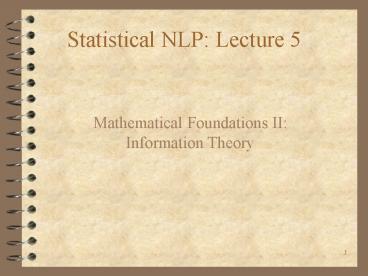Statistical NLP: Lecture 5 - PowerPoint PPT Presentation
Title:
Statistical NLP: Lecture 5
Description:
Statistical NLP: Lecture 5 Mathematical Foundations II: Information Theory Entropy The entropy is the average uncertainty of a single random variable. – PowerPoint PPT presentation
Number of Views:101
Avg rating:3.0/5.0
Title: Statistical NLP: Lecture 5
1
Statistical NLP Lecture 5
Mathematical Foundations II Information Theory
2
Entropy
- The entropy is the average uncertainty of a
single random variable. - Let p(x)P(Xx) where x ?X.
- H(p) H(X) - ?x?X p(x)log2p(x)
- In other words, entropy measures the amount of
information in a random variable. It is normally
measured in bits.
3
Joint Entropy and Conditional Entropy
- The joint entropy of a pair of discrete random
variables X, Y p(x,y) is the amount of
information needed on average to specify both
their values. - H(X,Y) - ?x?X ?y?Y p(x,y)log2p(X,Y)
- The conditional entropy of a discrete random
variable Y given another X, for X, Y p(x,y),
expresses how much extra information you still
need to supply on average to communicate Y given
that the other party knows X. - H(YX) - ?x?X ?y?Y p(x,y)log2p(yx)
- Chain Rule for Entropy H(X,Y)H(X)H(YX)
4
Mutual Information
- By the chain rule for entropy, we have H(X,Y)
H(X) H(YX) H(Y)H(XY) - Therefore, H(X)-H(XY)H(Y)-H(YX)
- This difference is called the mutual information
between X and Y. - It is the reduction in uncertainty of one random
variable due to knowing about another, or, in
other words, the amount of information one random
variable contains about another.
5
The Noisy Channel Model
- Assuming that you want to communicate messages
over a channel of restricted capacity, optimize
(in terms of throughput and accuracy) the
communication in the presence of noise in the
channel. - A channels capacity can be reached by designing
an input code that maximizes the mutual
information between the input and output over all
possible input distributions. - This model can be applied to NLP.
6
Relative Entropy or Kullback-Leibler Divergence
- For 2 pmfs, p(x) and q(x), their relative entropy
is - D(pq) ?x?X p(x)log(p(x)/q(x))
- The relative entropy (also known as the
Kullback-Leibler divergence) is a measure of how
different two probability distributions (over the
same event space) are. - The KL divergence between p and q can also be
seen as the average number of bits that are
wasted by encoding events from a distribution p
with a code based on a not-quite-right
distribution q.
7
The Relation to Language Cross-Entropy
- Entropy can be thought of as a matter of how
surprised we will be to see the next word given
previous words we already saw. - The cross entropy between a random variable X
with true probability distribution p(x) and
another pmf q (normally a model of p) is given
by H(X,q)H(X)D(pq). - Cross-entropy can help us find out what our
average surprise for the next word is.
8
The Entropy of English
- We can model English using n-gram models (also
known a Markov chains). - These models assume limited memory, i.e., we
assume that the next word depends only on the
previous k ones kth order Markov approximation. - What is the Entropy of English?
9
Perplexity
- A measure related to the notion of cross-entropy
and used in the speech recognition community is
called the perplexity. - Perplexity(x1n, m) 2H(x1n,m) m(x1n)-1/n
- A perplexity of k means that you are as surprised
on average as you would have been if you had had
to guess between k equiprobable choices at each
step.































